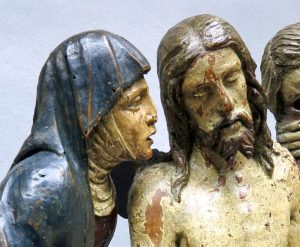
A Lombard Pietà
This touching relief, depicting Christ flanked by Mourning Virgin and San John and carved from a single block of wood, is a significant example of Lombard sculpture at the turn of the 15th century.
The lifeless body of Christ is tenderly supported on the left by the Virgin and on the right by Saint John, wiping off the tears from his eyes, resting the other hand on the edge of the sarcophagus.

The iconography of the Imago pietatis, the Pietà, has a Byzantine origin and in the Middle Ages it became increasingly human, with an intensifying pathetic and dramatic effect. Also, the hands or crossed arms of Christ recall the iconography of the Ecce Homo, thus creating a particularly meaningful connection for the faithful.

In the Renaissance, the Pietà iconography was particularly successful in the Lombard-Venetian area. Illustrious examples in painting are undoubtedly the two panels by Giovanni Bellini, one in Bergamo (Accademia Carrara) and the other in Milan (Pinacoteca di Brera), both dating to the mid 15th century. The sculpture can also recall the later lunette with the Pietà (Pinacoteca di Brera), datable to around the second half of the 1480s and attributed to Bergognone, which once surmounted a panel with Saint Jerome.
Like Bergognone’s painting, our Pietà is also conceived to be seen from below and this suggests that it might originally have been the top panel of a large sculpted altarpiece.

Compared to Bergognone’s painting in our relief the Christ’s anatomy is more accurately resolved and gives back a less evanescent physicality. After all, the choice of a body with well-developed musculature for the figure of Christ deposed or, as here, in Pietà, is a constant in the wooden and fictile groups of the Lombard area, which goes hand in hand with the search for a deliberately theatrical and dramatic language, aimed at moving the faithful.
Among the most important families of sculptors of the late 15th century is undoubtedly the Del Maino family. In particular, it seems appropriate to attribute the present sculpture to the circle of Giovan Angelo Del Maino; in fact, although slightly worn on the surface, the relief is still perfectly legible in its elegance, in the quality of the carvings of faces and drapery, as well as in the elongated anatomies.

This is confirmed by the comparison with the altar relief by the “Master of Trognano” in the basilica of Santa Maria del Monte sopra Varese (c. 1482-88) as well as the famous composition by the Mantegazza brothers now at the Victoria and Albert Museum in London (1475-1490, probably from the Certosa di Pavia).
Finally, it is worth mentioning the presence of a circular label on the back, attesting its provenance from the collection of an illustrious antique dealer from Turin, who was also a great collector: Pietro Accorsi (1891-1982), a friend of Umberto di Savoia, the supplier to some of Turin’s most important families and Vittorio Viale’s intermediary on behalf of the Museum of Palazzo Madama.

Giovan Angelo Del Maino (notices from 1494 to 1536), circle of
PIETÀ
Italy (Lombardy), circa 1480-1510
Carved and polychromed wood
Cm 41,5 x 49 h
Prov.: Turin; Pietro Accorsi Coll.; Turin, Private Collection.
© 2013 – 2024 cesatiecesati.com | Please do not reproduce without our expressed written consent
Alessandro Cesati, Via San Giovanni sul Muro, 3 – 20121 Milano – P.IVA: IT06833070151